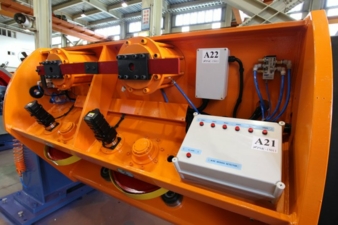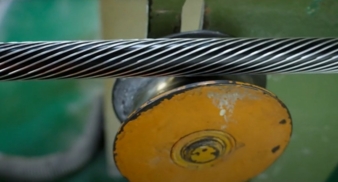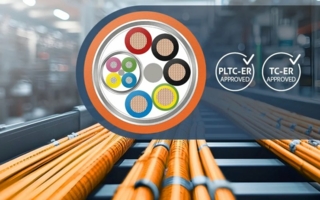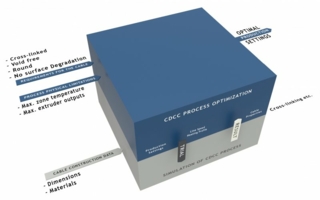14/04/2023 – Precision and efficiency with edge computing and servo control system
The future of cable stranding
For the cable stranding process, accurate tension control on pay off units has always been the key to achieve high-speed and stable production while maintaining the quality of the finished product.
In earlier times when traditional pneumatic brakes or even belt tensioning devices were commonly used, due to mechanical structure their performance was very limited. As a result, a non-contact Hysteresis brake system was introduced to improve product quality and stability. In the past two decades this technology has helped many cable factories produce higher quality cable.
Servo-control tension system
Nowadays, with the advancement of technology, Pioneer successfully upgraded our tension design to a precision servo control system and its supreme performance surpassed all the conventional tensioner systems. With the use of up-to-date electric technology, the precision servo technology has been successfully applied to produce high end cable such as extra high voltage cable, cable screening, control cable, composite cable, and copper and aluminum conductor cable.
Despite the servo control system's effectiveness, when there are more and more servo drives being deployed, sampling / calculating / closed loop controlling become a big challenge to the CPU of the PLC controller. This can lead to delay and lower resolution, causing tension control precision and stability issues and as a result affecting the quality of the final product.
To utilize the advantage of servo control systems, Pioneer’s R+D team developed an edge computing processor board. It acquires, processes and calculates raw data collected from the servo controller at very high precision and frequency. Moreover, multiple closed-loop systems are applied for correction / compensation of fullness / acceleration / inertial variation of the pay-off bobbins. By doing so, the PLC can focus on decision-making without being burdened by computing. An edge computing board maximizes the servo motor's characteristics of high precision and ultra-low delay.
Edge computing
Edge computing is a modern concept that instead of sending data from sensors to the central computer, it brings the computing power closer to the sources of data. This has been proved to greatly improve response time and also save bandwidth.
With edge computing, data from a servo-controller is gathered and processed just next to it, the edge computer therefore is able to collect / process this data at much higher frequency and resolution regardless of the limitation from network or PLC computing power.
Moreover, decentralized computing is another advantage of edge computing. It allows local devices to have its own computing power. Which means it can focus on its own and perform more complex tasks. In other words, decentralized computing can maintain its highest performance regardless of the growth of the control network, which is a great chance to us that the devices can handle more workloads without sacrificing their performance.
How do servo motor and edge computing improve the stability of the stranding machine?
The lower the tension error in the stranding process, the greater chance we can produce better-quality products at a higher speed. Pioneer adopted the servo control system because the servomotor has a faster response time and higher resolution than the pneumatic or hysteresis brakes. It allows the system to react immediately once the error occurs.
Inertia of the bobbins
When each pay-off bobbins from a stranding cage is running from fully loaded to empty, in order to keep the line tension constant, the actual required torque varies according to the reduced force arm. Furthermore, the rotational inertia of each bobbin also changes dramatically throughout the process which may have a serious impact to the effective tension force during line accelerating or decelerating.
The edge computer measures the linear speed and rotational speed signals in real-time, then calculate and update the physical parameters such as force arm, angle acceleration rate, and rotational inertia under the concept of so-called “digital twin technique” to build a virtual model of bobbin in cyber space and continuously modify the servo system torque demand to compensate the variations and achieve constant tension.
Response time to wire breakage
Wire breakage can be a nightmare for the stranding machine sometimes. Suppose the wire stops before the compacting dies, the production can be restarted in a few minutes after rejoining the broken wire.
However, if the wire is unfortunately dragged beyond the dies, then things become not that easy. It requires a lot of time to turn the machine backward and rethread the wire. For this reason many operators are reluctant to run the strander to the target speed to avoid such a risk.
The Edge Computing system uses differential calculations to quickly assess the actual payoff condition of each wire feeder. The system determines the occurrence of a wire break in microseconds, thus significantly reducing the stopping distance between the wire break and the machine stop.
Conclusion
The Servo system has improved the accuracy and stability of the tension control of the stranding machine. Also, edge computing reduces the delay of data transmission and the computation burden of PLC. In recent years, cable manufacturers have received much more diversified orders. Some require higher structural complexity. The others require higher quality. Although the process becomes more complex, these cables are worth a higher value. For those who want to get out of the price war, a more precise stranding machine can be your choice.
Interwire 2023, booth 1611
Pioneer Machinery USA
1275 Bloomfield Ave. Suite 43
Fairfield, NJ 07004, USA
Tel.: +1 973 2853211
info@pioneerm.com
www.pioneermachinery.us





